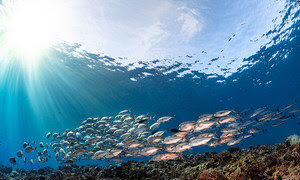by Nate Engle
“California, here we come!” I was singing this phrase in my head all morning a few weeks ago as I flew from Washington DC to Los Angeles to accompany a Government of Botswana study tour delegation. The phrase comes from a song by the group Phantom Planet and is the anthemic intro for the mid-2000s television series “The OC” (OC, standing for Orange County).I know it’s cheesy, but I really love this song. So do my children. They obsess over the melody as we gear up for our annual trip to visit extended family in the great Golden State. To them, it represents a new world, different landscapes, excitement, and that all-too-familiar pull of the western USA…possibility.
To me, it represents many of the same things, but for this trip, it was ringing in my ears for related, albeit slightly different reasons. On that flight, I was still thinking of this lure of the possible but specifically related to the topic of water. The possibility to thrive with very little water in a semi-arid desert climate. California has mastered this skill, and we were there to learn from some of the very best examples that the state has to offer. Botswana faces many similar threats to water security, such as increasing droughts from climate change, growth in demand, and significant infrastructure needs.
The World Bank Water Global Practice organized this technical exchange at the request of Botswana’s Honorable Kefentse Mzwinila, Minister of Land Management, Water, and Sanitation Services. To meet their request, we organized three strategic stops in California, as well as subsequent meetings with the World Bank and IFC staff in Washington DC.
First up, the OC. We jumped right into the heart of where this tune’s associated television series is set. Along the coast, just to the south of Los Angeles County, Orange County is known for its expansive sandy beaches, surfing culture, and Disneyland. But we were there for different reasons. Mainly, to visit the Orange County Water District’s Groundwater Replenishment System (GWRS). As a 378,500 m3/day advanced water purification system, the GWRS stakes its claim as the largest potable reuse facility in the world. We toured the plant and learned about the process of taking treated sewer water, purifying it to near-distilled water quality, and then recharging it back into the groundwater basin for future extraction and treatment as drinking water. The delegation was particularly intrigued by the potential of this approach, given the similar underlying geologic formations in Botswana, and the attractiveness of utilizing wastewater as an “asset”. There was broad recognition however that significant outreach would be needed in Botswana (as is the case with most countries) to shift public perception, as the “yuck” factor can be a major barrier to the success of a potable reuse project.
Next, we made our way up to Los Angeles, thankfully in the opposite direction of the infamous traffic jams, to meet with water resources planners from the Metropolitan Water District of Southern California (MWD). MWD is the regional water wholesaler to 26 member agencies, which service approximately 19 million California residents with drinking water; half of the state’s entire population. Here, the delegation learned about the intricate network of conveyance infrastructure that transports water into the Los Angeles region from all over the state and Colorado River Basin. The focus of discussion during this stop though was the iterative integrated water resources planning process that the MWD has implemented for the past two decades that helps them prioritize investments and diversify their water portfolio. The Botswana team is now very keen to initiate a similar process, in part supported by the World Bank’s Botswana Emergency Water Security and Efficiency Project.
The final stop was San Diego, with visits to meet with officials and technical staff of the San Diego County Water Authority and the City of San Diego, and to tour the Claude “Bud” Lewis Carlsbad Desalination Plant. The most interesting part of this day was by far the visit to the plant itself. It is technically interesting in that it is the largest seawater desalination plant in North America, but it is also interesting from a project finance perspective. It has utilized a unique PPP framework to construct and operate the plant. Key takeaways for the delegation were that to make this PPP successful, it required risk transfer to the private sector, price certainty through a water purchase agreement, buy-out provisions for the public sector, and an eventual transfer to public ownership.
After an intense two days, we left for Washington DC with many insights and ideas to take back to Botswana and support the country in its pursuit of long-term water security. I personally came away with the affirmation that California, and more broadly the western United States, is indeed the land of the possible. The opportunities for us to support our clients through learning exchanges like this are boundless.
And as the follow-up

lyric in the song suggests, “California here we come…right back where we started from”, I hope we can bring many more clients back to this region in the future, perhaps through a more structured study tour/exchange program, to learn how to better thrive in the face of water stress, climate change, and myriad similar challenges facing our clients around the world.
Submitted by Nate Engle On Wed, 12/05/2018




